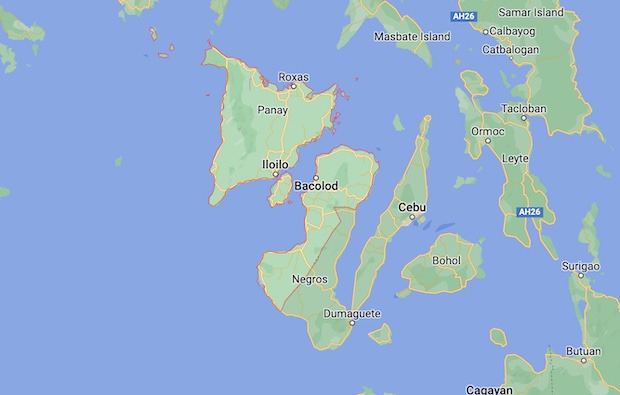
Western Visayas (outlined in red from Google Maps)
BACOLOD CITY — A group of lawmakers from Western Visayas has asked the House of Representatives to look into the power outages that occurred on the last days of April.
House Resolution No. 933 aims to urge the committee on energy of the lower chamber to look into the series of power disruptions on April 27, 28, and 29 on the islands of Panay, Guimaras, and Negros and to come up with legislative solutions to prevent similar incidents in the future.
“While the National Grid Corporation of the Philippines (NGCP) stated that it has been coordinating with generators and distribution utilities to work on the expeditious restoration of affected NGCP lines and facilities, it also clarified that power supply, distribution, and transmission are three different parts of the power system and that NGCP, as the transmission provider, has no stake in power supply nor distribution’,” the resolution read.
“Such statement could cause more confusion and therefore, there is a need to find out what really triggered the power outage and who should be made accountable,” it added.
The power outages occurred in the early afternoons of April 27 and 28, and the morning of April 29.
The resolution was filed by Representatives Julienne Baronda (Iloilo City, lone district), Michael Gorriceta (Iloilo, second district), Lorenz Defensor (Iloilo third district), Raul Tupas (Iloilo fifth district), Jose Francisco Benitez (Negros Occidental third district), and James Ang Jr. (Uswag Ilonggo Party-List).
The power outages in some parts of Western Visayas were traced to a distribution line owned by the Central Negros Electric Cooperative Inc. (Ceneco), a distribution utility that serves power to Bacolod City, Negros Occidental’s capital and its neighboring towns and cities.
The Inquirer tried but failed to reach Congressman Ang, a member of the House committee on energy.
On April 30, the NGCP successfully energized the P52-billion Mindanao-Visayas Interconnection Project (MVIP) which would help provide a stable supply of power in the two regions.
An initial load of 22.5 megawatts (MW) was carried by the high-voltage submarine and overhead lines from Mindanao to Visayas during MVIP’s energization.
“We expect to gradually increase the MVIP’s transfer capacity to 50 MW by mid-May, and 112 MW by the end of the month, before energizing to its full transfer capacity of 450 MW by the third quarter of this year,” said the NGCP in a press statement.
The MVIP is a 184 circuit-kilometer (ckm) high-voltage direct current (HVDC) submarine transmission line connecting the power grids of Mindanao and Visayas with a transfer capacity of 450 MW and expandable to as much as 900 MW.
The project also includes converter stations in both regions and more than 500 ckm of overhead lines to facilitate the flow of electricity.
“The completion of the Mindanao-Visayas Interconnection Project is a significant achievement for us and for the Philippines as a whole. This will not only improve the reliability of our transmission services but will lead to efficient energy utilization as one Philippine grid,” the NGCP said.
The MVIP was envisioned to benefit consumers by providing them with a more reliable and sustainable power transmission service that will lessen power interruptions.
It will also promote energy resource sharing as excess power generated in one region can now be transmitted to the other.
In 2022, parts of the MVIP were completed such as the Lala-Aurora 138 kilovolt (kV) Transmission Line, the 350kV Submarine Cable, the Cable Terminal Stations in Santander, Cebu and in Dapitan, Zamboanga del Norte.
NGCP expects to complete the remaining components of the project and ramp up the transfer capacity of the facility in the coming months.
RELATED STORIES
Marcos Orders Ngcp to Resolve Western Visayas Power Crisis
Probe into Panay Island power woes pushed in Senate
Palace, energy execs under fire and pressed for answers for nationwide …